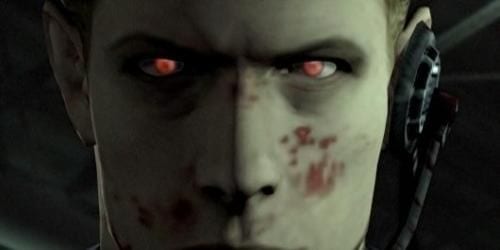
While we’re still waiting for the Citizen Kane of video games, perhaps the survival-horror genre has already surpassed its film kin. It’s certainly better poised to scare, as the use of an avatar personalizes the danger in a way that films cannot. Playing a horror game is in a way closer to walking through a haunted house than watching a horror film. The tactile involvement and decision-making elements create a deeper horror experience. Granted, the bar is a bit lower for horror than for other genres of film, as typical horror movies aren’t exactly the highest art form, but it’s a promising mile marker in the evolution of the games medium. While story and dialogue (Resident Evil is notorious for its wooden voice acting) take a back seat to thrills and chills, Resident Evil serves up the heebie jeebies in abundance.
To make a long and convoluted story short, Raccoon City is infested with zombies due to a shadowy organization called Umbrella’s clandestine experiments with the T-virus, exposure to which will turn you into a drooling, decomposing cannibal. The plot is actually quite inventive, as the traditional zombie story begins with some kind of Haitian voodoo rather than scientific experimentation for paramilitary purposes. This conflict between the scientific and the supernatural is an eerie cultural critique, a popular theme in Japanese pop art. It’s no surprise that the game comes from the same nation that brought us Akira and a host of other manga that deals with similar plot elements.
This game is more about good ol’ geysers of blood and decapitations than Eastern philosophizing and social commentary, so don’t expect too much zombie zen. Umbrella Chronicles allows you to play from the perspective of several of the game’s characters, most notably Albert Wesker, a mysterious villain with unknown intentions. Although the game raises just as many questions as it answers, superfans will surely relish the narrative crumbs dropped from the table as they discover a bit more about Wesker’s motivation.
In the first installment in the Resident Evil franchise, you must walk down a hallway to reach a significant room. Although the corridor is well-lit and seemingly zombie-free, you prepare yourself for the worst, inching forward, waiting for some unamiable beastie to appear. Nothing happens. You shrug your shoulders, grab an item and run back down the hallway. Just when you least expect it, a snarling, undead canine bursts through the window and lunges straight for your jugular. It’s widely regarded as one of the most singularly terrifying moments in gaming, and could easily rank high with landmark horror moments in film as well.
Even an animal rights activist wouldn’t hesitate to
pull the trigger when faced with this thing.
Moments like that seminal scare are unfortunately lacking in Umbrella Chronicles. Despite the creepy crawlies the game constantly throws at you, it’s never scary, due to a constant stream of suspenseless gameplay. Due to the nature of on-rails play, you don’t have control over each step, so there’s no building sense of fear or dread.
And yet, the game provides longtime fans with a fresh perspective, one that fills in gaps in the often nonsensical storyline. If you’re not familiar with the Resident Evil canon, forget about understanding what in the world is going on here. I’ve played through several of the games but had difficulty keeping up with the series’ myriad supporting characters and their respective affiliations. Culling familiar scenes from the first and third Resident Evil games along with a prequel, Umbrella Chronicles feels like a victory lap, or a highlight reel. It’s not meant to keep you awake at night, just to provoke moments of, “Oh yeah, I remember that. That was awesome!”
A measly little fire won’t slow him down.
The game utilizes the arcade-style on-rails perspective, meaning that the player controls the gun but not the movement of the character, as if he/she were “on rails”, propelled through each level independently. While this can be frustrating for players used to independent movement, it allows the developer to evoke a more cinematic feel more akin to a film than a traditional shooter. By eliminating movement, the player is freed to focus solely on strategically taking out hordes of the undead.
You’re faced with decisions like: “Do I blow out that zombie’s kneecap, delaying his approach enough that I can pop his dome a few times?”, “Should I conserve my submachine gun ammo for the boss, where I’ll need it to target a glowing-red weak point?”, and “Should I spray the crowd with my shotgun, giving me enough time to lob a grenade or should I just take them down with my pistol, one by one?” There’s a surprising amount of tactical maneuvering that you must undertake in order to successfully complete each level. Most levels climax with a boss battle, some of which will go down as high points in the franchise.
There are buckets of extras thrown in for the fans, who will see this installment as a stopgap rather than a step back for the franchise. It may not be spooky, but that doesn’t stop it from being a lot of fun. If anything, it serves as a nice recap for those licking their lips in anticipation of Resident Evil 5.

![Call for Papers: All Things Reconsidered [MUSIC] May-August 2024](https://www.popmatters.com/wp-content/uploads/2024/04/all-things-reconsidered-call-music-may-2024-720x380.jpg)



